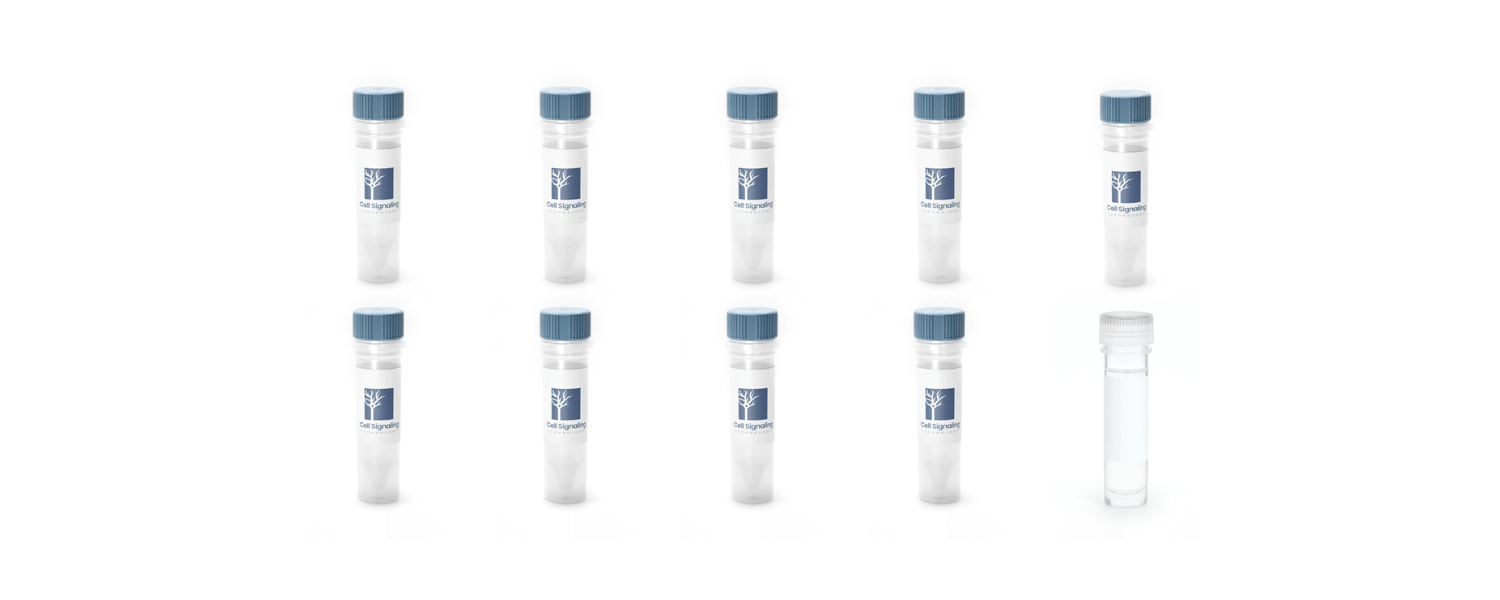Several different assays can be used to measure metabolism in a variety of contexts. These include methods to directly determine metabolic rates, as well as to examine key signaling pathways and environmental cues, like hypoxia and oxidative stress, which directly influence metabolism under normal and pathological conditions.
Biomarkers and Assays to Assess Hypoxia and Oxidative Stress
Hypoxia and oxidative stress are both a cause and consequence of alterations in cellular metabolism.
- Expression of HIF-1α, a transcription factor and master regulator of cellular hypoxia response pathways, is significantly upregulated in response to a low O2 environment. CST antibodies to HIF1 can be used to examine these changes via an array of assays, including western blotting and ELISA. Elevated HIF-1α expression would indicate that cells or tissues are likely exposed to hypoxia in their model system.
- As a transcription factor, HIF-1α activates the expression of a broad range of downstream targets. Examination of these targets in combination with assessing HIF-1α levels provides valuable confirmation of ongoing cellular processes related to hypoxia and oxidative stress.
 |
Download the Hypoxia Signaling Pathway Diagram to explore key protein targets and associated CST products. |
Measuring Mitochondrial Respiration
Mitochondria are cellular organelles that serve as the primary energy factories to support cellular function. The conversion of metabolites from the TCA cycle into ATP is achieved by the transfer of electrons from these intermediates through the respiratory chain on the mitochondrial inner membrane. Assays to examine mitochondrial respiration provide a direct readout of cellular metabolic activity.
- Mitochondrial respiration and function can be examined by measuring key biomarkers of mitochondrial activity. These include SDHA and COX1, as well as the Tricarboxylic Acid Cycle Antibody Sampler Kit.
Assessing Mitochondrial Integrity
Mitochondrial integrity is essential for the regulation of cellular energy and the control of apoptosis.
- Mitochondrial integrity can be measured with antibodies available in the Mitochondrial Membrane Potential Assay Kit (II) and by examining biomarkers, including cytochrome C, which is released from mitochondria into the cytosol during the initiation of apoptosis.
Measuring Amino Acid Metabolism
Amino acids are the building blocks of cellular proteins and also serve as key nutrients to fuel cellular processes. For example, glutamine is an important metabolic fuel that helps rapidly proliferating cells meet their demands for ATP. Direct links to CST products available to study amino acid metabolism, including key enzymes like GLS, IDH1, and IDH2 are accessible via the CST Glutamine Metabolism Interactive Pathway.
 |
Explore the interactive Glutamine Metabolism Pathway, along with associated CST antibody products. |
Measuring mTOR Activity
The mechanistic target of rapamycin (mTOR) is a serine/threonine kinase that serves as a master regulator of cell growth and metabolism. mTOR integrates signaling from extracellular growth factors, cytokines, and acts as a nutrient sensor to affect multiple cellular processes, including cell proliferation, survival, cell growth, and protein translation.
 |
Explore the interactive mTOR Signaling Pathway, along with associated CST antibody products. |
mTOR exists in two distinct signaling complexes, termed mTORC1 and mTORC2, that receive signaling inputs primarily via the PI3K/AKT, ERK1/2, and AMPK pathways. Key downstream targets of mTORC1 include p70/S6K and 4E-BP1/2, while mTORC2 transduces signals via SGK1, PKCa, and AKT. Components of mTOR signaling can be queried using reagents from the CST mTOR substrate sampler kit, which includes:
| Antibody Target | Description |
| mTOR | Serine/Threonine Kinase |
| Phospho-p70 S6 kinase (Thr389) | Downstream effector of mTORC1, Thr389 correlates with kinase activity |
| Phospho-p70 S6 kinase (Ser371) | Downstream effector of mTORC1, Ser371 correlates with kinase activity |
| Phospho-4E-BP1 (Thr37/46) | Downstream effector of mTORC1, inhibits cap-dependent translation, Thr37/46 are readouts of mTOR activity |
| Phospho-mTOR (Ser2448) | mTOR Ser2448 is phosphorylated via PI3K/AKT activation |
Assessing AMPK Activity: A Master Regulator of Metabolism
AMP-activated protein kinase (AMPK) is a master regulator of cellular energy homeostasis that modulates both glucose and lipid metabolism. AMPK phosphorylates downstream targets to regulate glucose metabolism (e.g., PFKFB3, GYS1), lipid metabolism (e.g., HMGR, ACC1, PLD1), transcription (e.g., HDAC4/5/7, p300, SREBP1), and cell growth/autophagy (e.g., Raptor, ULK1, Beclin-1). Components of AMPK signaling can be queried using reagents from the AMPK substrate sampler kit which includes:
| Antibody Target | Description |
| AMPKα (D5A2) | Serine/Threonine Kinase |
| Phospho-AMPKα (Thr172) | Serine/Threonine Kinase, phosphorylation at Thr172 is essential for activation |
| ULK1 (D8H5) | Serine/Threonine Kinase and downstream effector of AMPK linked to autophagy |
| Phospho-ULK1 (Ser555) | Phosphorylation of ULK1 by AMPK at Ser555 is critical for starvation-induced autophagy, cell survival under conditions of low nutrients and energy, and mitochondrial homeostasis |
| Raptor | AMPK substrate and component of mTORC1 |
| Phospho-Raptor (Ser792) | Serine 792 (ser729) is phosphorylated by AMPK to inhibit mTORC1 |
| Beclin-1 | Downstream effector of AMPK linked to autophagy |
| Phospho-Beclin-1 (Ser93) | In humans, serine 93 (ser93) is phosphorylated by AMPK, which induces autophagy. The corresponding residue in mice is Ser91. |
Measuring the Warburg Effect
The Warburg Effect is a metabolic adaptation of many cancers that promotes cancer cell growth and survival. Specifically, cancer cells tend to favor metabolism via glycolysis over the more efficient and commonly used oxidative phosphorylation pathway even in the presence of oxygen. Several signaling pathways, including activation of the PI3K/AKT and RAS, contribute to the Warburg effect. In addition, a dimeric form of the pyruvate kinase isoenzyme M2 (PKM2) is thought to play a central role in the Warburg effect. One hallmark of the Warburg effect is increased production of lactate.
 |
Explore the interactive Warburg Effect Pathway Diagram, along with associated CST antibody products. |
Assessing Insulin Receptor (IR) Signaling
Insulin, the major hormone controlling cellular energy functions such as glucose and lipid metabolism, acts by binding to and activating the insulin receptor tyrosine kinase.
 |
Explore the interactive Insulin Receptor Signaling Pathway Diagram, along with associated CST antibody products. |
Receptor activation induces the recruitment of the IRS family of adaptor proteins and downstream activation predominantly through the PI3K/AKT and ERK1/2 pathways to affect numerous cellular processes. Components of insulin receptor signaling can be assayed using reagents in the CST Insulin Receptor Substrate Antibody Sampler Kit, which includes:
| Antibody / Target | Description |
| IRS-1 (D23G12) Rabbit mAb #3407 | Insulin Receptor signaling adaptor protein |
| Phospho-IRS-1 (Ser307) Antibody #2381 | Ser3017 is phosphorylated by JNK and IKK |
| Phospho-IRS-1 (Ser612) (C15H5) Rabbit mAb #3203 | Ser612 phosphorylation is mediated by the PKC and mTOR pathways. |
| Phospho-IRS-1 (Ser318) (D51C3) Rabbit mAb #5610 | Downstream effector of mTORC1, inhibits cap-dependent translation; Thr37 and Thr46 are readouts of mTOR activity. |
| IRS-2 Antibody #4502 | Insulin Receptor signaling adaptor protein |
Additional Chemical-Based Assays to Measure Metabolism
Several additional methods exist to measure the levels and activities of key metabolic processes in cells. These include:
- The detection of oxidative cofactors including, NAD+/NADH and NADP+/NADPH, is typically done via colorimetric analysis of cell extracts on a microplate reader
- Quantification of S-Adenosylmethionine and S-Adenosylhomocysteine, central components of the methylation cycle, by HPLC or colorimetric assay of cell lysates.




/42157_chimeric%20antibody%20blog%20featured3.webp)


